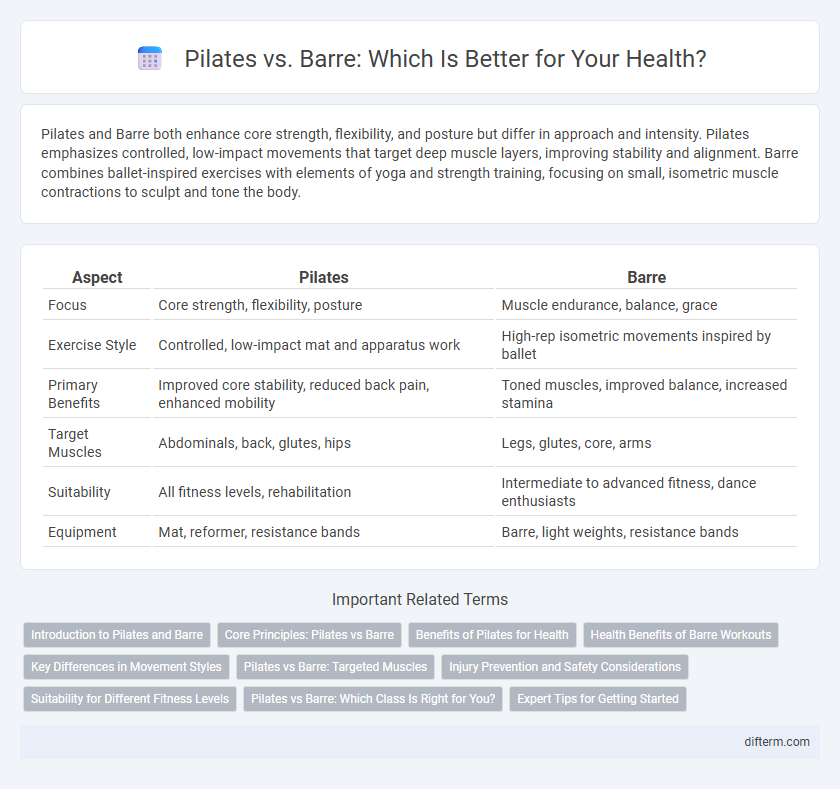Pilates and Barre both enhance core strength, flexibility, and posture but differ in approach and intensity. Pilates emphasizes controlled, low-impact movements that target deep muscle layers, improving stability and alignment. Barre combines ballet-inspired exercises with elements of yoga and strength training, focusing on small, isometric muscle contractions to sculpt and tone the body.
Table of Comparison
| Aspect | Pilates | Barre |
|---|---|---|
| Focus | Core strength, flexibility, posture | Muscle endurance, balance, grace |
| Exercise Style | Controlled, low-impact mat and apparatus work | High-rep isometric movements inspired by ballet |
| Primary Benefits | Improved core stability, reduced back pain, enhanced mobility | Toned muscles, improved balance, increased stamina |
| Target Muscles | Abdominals, back, glutes, hips | Legs, glutes, core, arms |
| Suitability | All fitness levels, rehabilitation | Intermediate to advanced fitness, dance enthusiasts |
| Equipment | Mat, reformer, resistance bands | Barre, light weights, resistance bands |
Introduction to Pilates and Barre
Pilates emphasizes core strength, flexibility, and body awareness through controlled, low-impact movements designed to improve posture and balance. Barre combines elements of ballet, yoga, and Pilates, targeting muscle endurance and toning with repetitive, small range-of-motion exercises often performed at a ballet barre. Both methods enhance overall fitness but differ in style and focus, with Pilates centering on core control and Barre on sculpting and lengthening muscles.
Core Principles: Pilates vs Barre
Pilates emphasizes controlled, precise movements that enhance core strength, flexibility, and posture through breath control and concentration. Barre combines elements of ballet, yoga, and Pilates, focusing on small, isometric movements that target muscle endurance, balance, and core stability. Both methods prioritize core engagement but differ in technique and overall fitness goals, with Pilates favoring fluidity and Barre emphasizing muscle toning.
Benefits of Pilates for Health
Pilates improves core strength, flexibility, and posture, reducing the risk of injury and chronic pain. It enhances muscle tone and endurance while promoting better balance and coordination through controlled, low-impact movements. Consistent Pilates practice supports mental health by reducing stress and increasing body awareness.
Health Benefits of Barre Workouts
Barre workouts enhance overall health by improving posture, increasing flexibility, and strengthening core muscles, which reduces the risk of injury. This low-impact exercise also supports cardiovascular health by promoting endurance and stimulating blood circulation. Consistent barre practice aids in stress reduction and boosts mental well-being through focused, controlled movements.
Key Differences in Movement Styles
Pilates emphasizes controlled, low-impact movements that strengthen core muscles and improve overall stability through precise mat and apparatus exercises. Barre incorporates ballet-inspired movements with isometric holds and small, pulsing actions targeting muscle endurance, balance, and flexibility. While Pilates focuses on alignment and breath coordination for core strength, Barre combines cardio elements and dance-based techniques to enhance muscle tone and agility.
Pilates vs Barre: Targeted Muscles
Pilates primarily targets the deep core muscles, including the transverse abdominis, pelvic floor, and multifidus, enhancing stability and posture. Barre focuses on small, isometric movements that engage the glutes, thighs, and calves while also activating the core for balance. Both methods emphasize muscle endurance and alignment but differ in their primary muscle activation and approach to strengthening.
Injury Prevention and Safety Considerations
Pilates emphasizes core strengthening and controlled movements that enhance muscular balance, reducing the risk of common injuries such as strains and joint misalignments. Barre combines low-impact ballet-inspired exercises with isometric holds, promoting flexibility and joint stability, which helps prevent overuse injuries. Both practices require proper form and instructor guidance to maximize safety and minimize injury risk during workouts.
Suitability for Different Fitness Levels
Pilates offers scalable exercises suitable for beginners to advanced practitioners, emphasizing core strength and flexibility that can be modified for individual fitness levels. Barre combines ballet-inspired movements with strength training, appealing to those seeking low-impact, high-intensity workouts that enhance muscular endurance and posture. Both Pilates and Barre accommodate various fitness abilities, making them accessible options for improving overall body conditioning.
Pilates vs Barre: Which Class Is Right for You?
Pilates emphasizes core strength, flexibility, and controlled movements using mats or specialized equipment, making it ideal for individuals seeking low-impact full-body conditioning. Barre combines ballet-inspired moves with cardio and strength training, focusing on small, isometric pulses to tone muscles, particularly appealing to those aiming for sculpted arms, legs, and glutes. Choosing between Pilates and Barre depends on fitness goals: Pilates excels in improving posture and core stability, while Barre offers enhanced muscular endurance and graceful toning.
Expert Tips for Getting Started
Starting Pilates focuses on controlled breathing, precise movements, and core engagement to improve flexibility and strength, while Barre emphasizes small, isometric exercises targeting muscle tone and posture. Experts recommend beginners invest in a quality mat and attend beginner classes for proper form to prevent injury in Pilates, whereas Barre beginners should wear supportive shoes and use a barre or sturdy surface for balance. Both disciplines benefit from consistency, with gradual progression in intensity and attention to body alignment critical for maximizing results.
Pilates vs Barre Infographic

 difterm.com
difterm.com